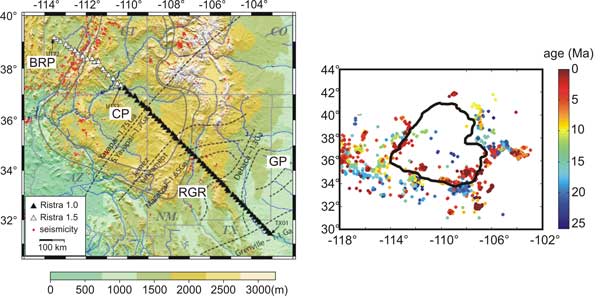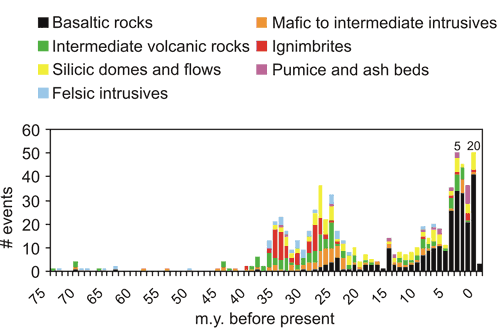 |
Intraplate
Magmatism in the Southwestern US: The Colorado
Plateau Edges |
Jolante
van Wijk1, W.
Scott Baldridge2,
Jeroen
van Hunen3, Saskia
Goes4,
Rick
Aster5,
David
Coblentz2, Steve
P. Grand6, & James
Ni7
1Dept.
Earth & Atmospheric Sciences, Univ. Houston,
312 Science & Research Bldg. 1, Houston, Texas
77204, USA, jwvanwijk@uh.edu
2Earth
& Environmental Sciences Division, Los Alamos National
Laboratory, Los Alamos, New Mexico 87545, USA, sbaldridge@lanl.gov ; coblentz@lanl.gov
3Dept.
Earth Sciences, Durham Univ., Durham DH1 3HP, UK, jeroen.van-hunen@durham.ac.uk
4Dept.
Earth Science and Engineering, Imperial College, London
SW7 2AZ, UK, s.goes@imperial.ac.uk
5Dept.
Earth
& Environmental Science & Geophysical Research
Center, New Mexico Institute of Mining & Technology,
Socorro, New Mexico 87801, USA, aster@ees.nmt.edu
6Dept.
Geological Sciences, Univ. Texas, Austin, Texas 78712,
USA, steveg@maestro.geo.utexas.edu
7Dept.
Physics, New Mexico State Univ., Las Cruces, New Mexico
88003, USA, jni@nmsu.edu
This webpage is a summary of: Van
Wijk, J.W., W.S. Baldridge, J. van Hunen, S. Goes,
R. Aster, D. Coblentz, S.P. Grand, J. Ni, Small-scale
convection at the edge of the Colorado Plateau: Implications
for topography, magmatism, and evolution of Proterozoic
lithosphere. Geology, 38,
611 614, doi:10.1130/G31031.1, 2010.
In the southwestern US, Cenozic magmatism is abundant.
It occurs far away from the nearest plate boundary,
as far east as New Mexico and Colorado (Figure 1).
Some of this magmatic activity is very young. The Socorro
magma body near Socorro, New Mexico, is currently developing,
for example. Since about 15 Ma, much volcanic activity
seems to concentrate around the edges of the Colorado
Plateau. The Colorado Plateau is a tectonically stable
province consisting of Proterozoic lithosphere. It
has remained relatively undeformed and unaffected by
recent tectonic events that formed the Basin and Range
Province toward its western and southern edges, and
the Rio Grande rift zone southeast of the Colorado
Plateau.

Figure 1. Topographic
map of Colorado Plateau region, with seismicity (red
dots). CP= Colorado Plateau, BRP= Basin and Range Province,
RGR= Rio Grande rift, GP= Great Plains. The black and
white triangles denote the location of seismic stations
of the La RISTRA seismic experiment (West
et al., 2004;
Wilson
et al., 2005). The right panel shows ages and
locations of Cenozoic volcanism in the Colorado Plateau
region. The Colorado Plateau is outlined in black.
A closer look at Cenozoic magmatism in the western
US reveals an interesting pattern. Magmatism was not
continuous. A middle, Cenozoic pulse was separated
from a younger Late Neogene-Quarternary pulse by a
period of relative quiescence (Figure 2). The middle
Cenozoic magmatism is intermediate to silicic and virtually
absent on the Colorado Plateau. The Late Neogene-Quarternary
pulse is fundamentally basaltic and present on the
edges of the Colorado Plateau. We interpret these phases
as resulting from separate geodynamic events and focus
here on an explanation for the most recent event. Earlier
studies (Humphreys et al.,
2003; Christensen & Yeats,
1992; Dickinson,
1997) have documented and
explained the mid-Cenozoic event.

Figure 2. K-Ar and 40Ar/39Ar
igneous rocks ages in New Mexico (for source of data,
see van Wijk
et al., 2010).
What causes the recent pulse of volcanism on the Colorado
Plateau edges? When extension of the lithosphere formed
the Basin and Range Province and Rio Grande rift zone,
the lithosphere in these continental rifts thinned
(Wernicke et al., 1992; West et al.,
2004; Wilson et al.,
2005). This resulted
in a variation in depth of the lithosphere-asthenosphere
boundary between the Colorado Plateau and these extended
areas (Colorado Plateau lithosphere is thicker than
surrounding lithosphere of the extended Basin & Range
and Rio Grande rift areas). This step in lithosphere
thickness causes small scale convection (edge driven
convection) in the upper mantle (Figure 3).

Figure 3. A small-scale convection
cell develops at the edge of the Colorado Plateau.
An instability grows through lateral addition of mantle
lithosphere, which locally thins the lithosphere. Melting
occurs at the edge of the Plateau.
Mantle lithosphere material feeds the instability
(drip) that is being formed, and this process thins
the mantle lithosphere at the edge of the Colorado
Plateau. A convection cell develops and asthenosphere
is brought up below the plateau edges. The geotherm
crosses the solidus below the edges, resulting in partial
melting and volcanism.
Edge-driven convection occurs when the depth of the
lithosphere-asthenosphere boundary varies laterally. King & Anderson (1998) found edge driven convection at the edges of cratonic
provinces, and suggested that igneous provinces such
as the North Atlantic Igneous Province could be formed
by this process. In our models, edge-driven convection
occurs also when the depth to the lithosphere-asthenosphere
boundary varies laterally only modestly, such as between
the Colorado Plateau and surrounding extended provinces.
More information about this study can be found in van
Wijk et al.
(2010).
References
-
Christiansen, R.L., and Yeats, R.S., 1992, Post-Laramide
geology of the U.S. Cordilleran region, in Burchfiel,
B.C., et al., eds., The Cordilleran Orogen: Conterminous
U.S.: Boulder, Colorado, Geological Society
of America, Geology of North America, v. G-3, p.
261–406.
-
-
Humphreys, E., Hessler, E., Dueker, K., Farmer,
G.L., Erslev, E., and Atwater, T., 2003, How Laramide-age
hydration of North American lithosphere by the Farallon
slab controlled subsequent activity in the western
United States: International Geology Review, 45,
575–595, doi: 10.2747/0020-6814.45.7.575.
-
-
Van Wijk, J.W., W.S. Baldridge, J. van Hunen, S.
Goes, R. Aster, D. Coblentz, S.P. Grand, J. Ni, Small-scale
convection at the edge of the Colorado Plateau: Implications
for topography, magmatism, and evolution of Proterozoic
lithosphere. Geology, 38,
611 614, doi:10.1130/G31031.1, 2010.
-
Wernicke, B., Cenozoic extensional
tectonics of the U.S., in Burchfiel, B.C. et a.,
eds., The
Cordilleran Orogen: Conterminous U.S., Boulder,
Colorado, Geological
Society of America, Geology of North America, v. G-3, p. 553-581.
-
West, M., Ni, J., Baldridge, W.S., Wilson, D.,
Aster, R., Gao, W., and Grand, S., 2004, Crust and
upper mantle shear wave structure of the southwest
United States: Implications for rifting and support
for high elevation: Journal
of Geophysical Research, 109,
B03309, doi: 10.1029/2003JB002575.
-
Wilson, D., R. Aster, M. West, J. Ni, S. Grand,
W. Gao, W.S. Baldridge, S. Semken, Lithospheric structure
of the Rio Grande rift. Nature, 433,
851-855, doi:10.1038/nature03297.
last updated 2nd
March, 2011 |
